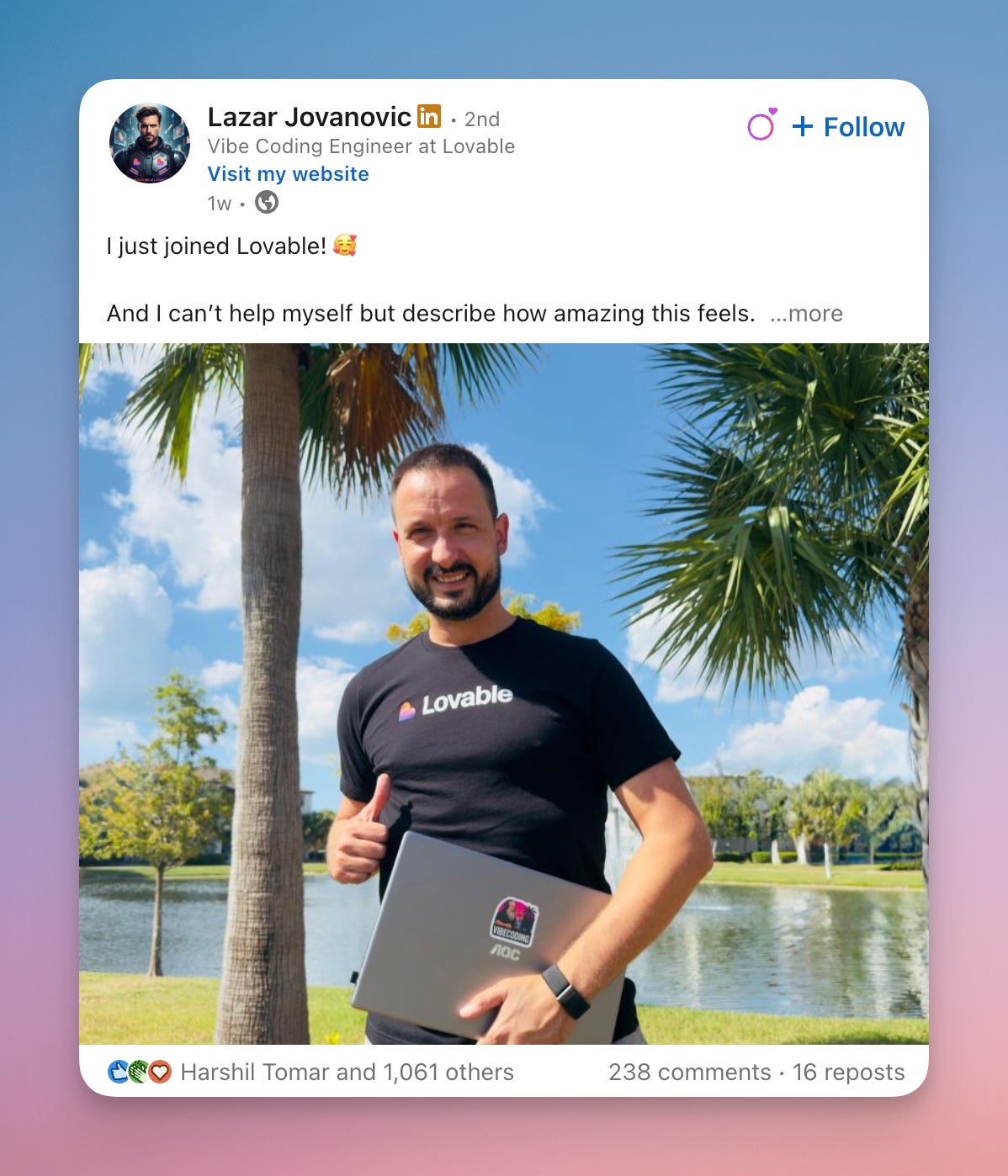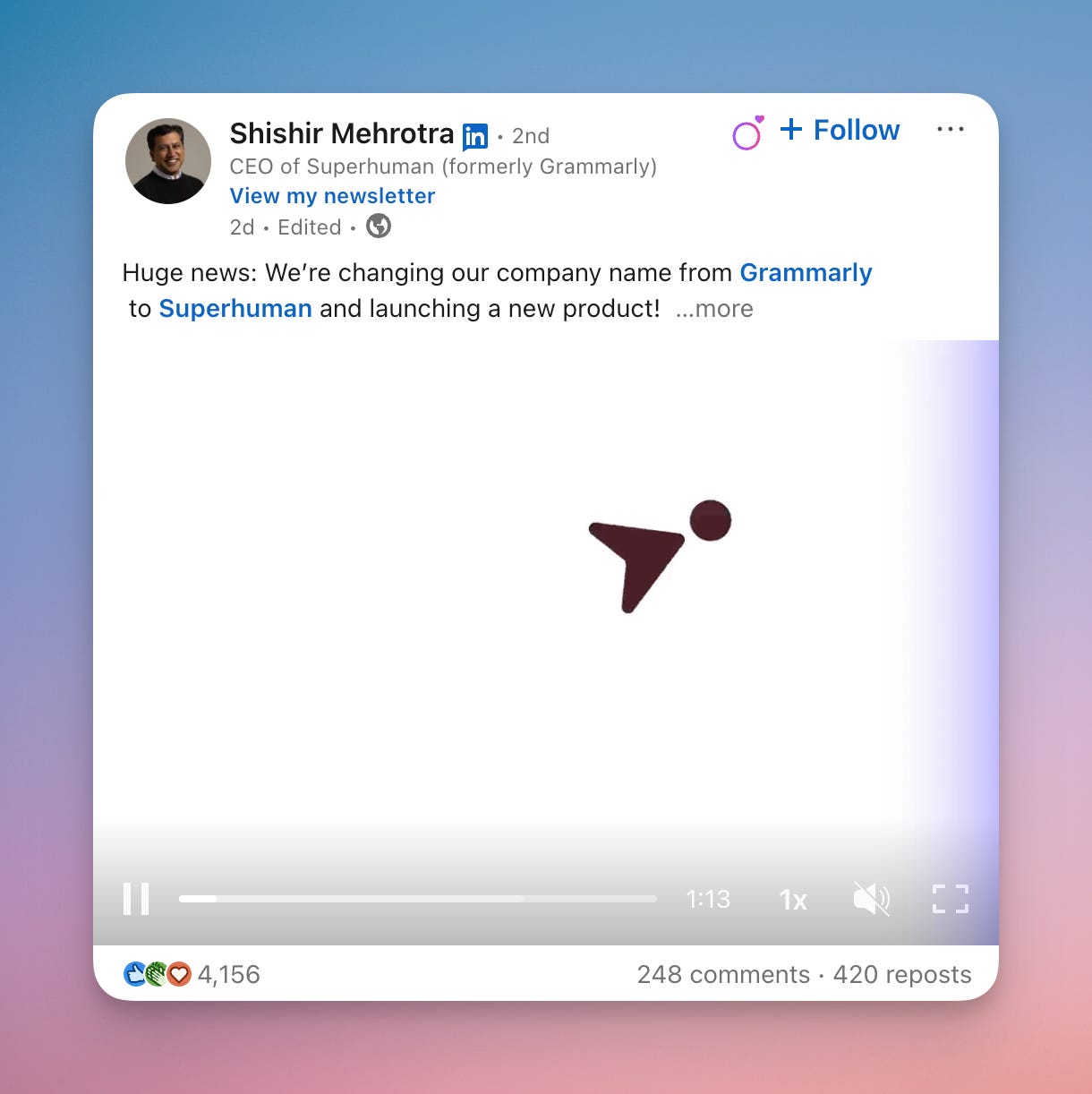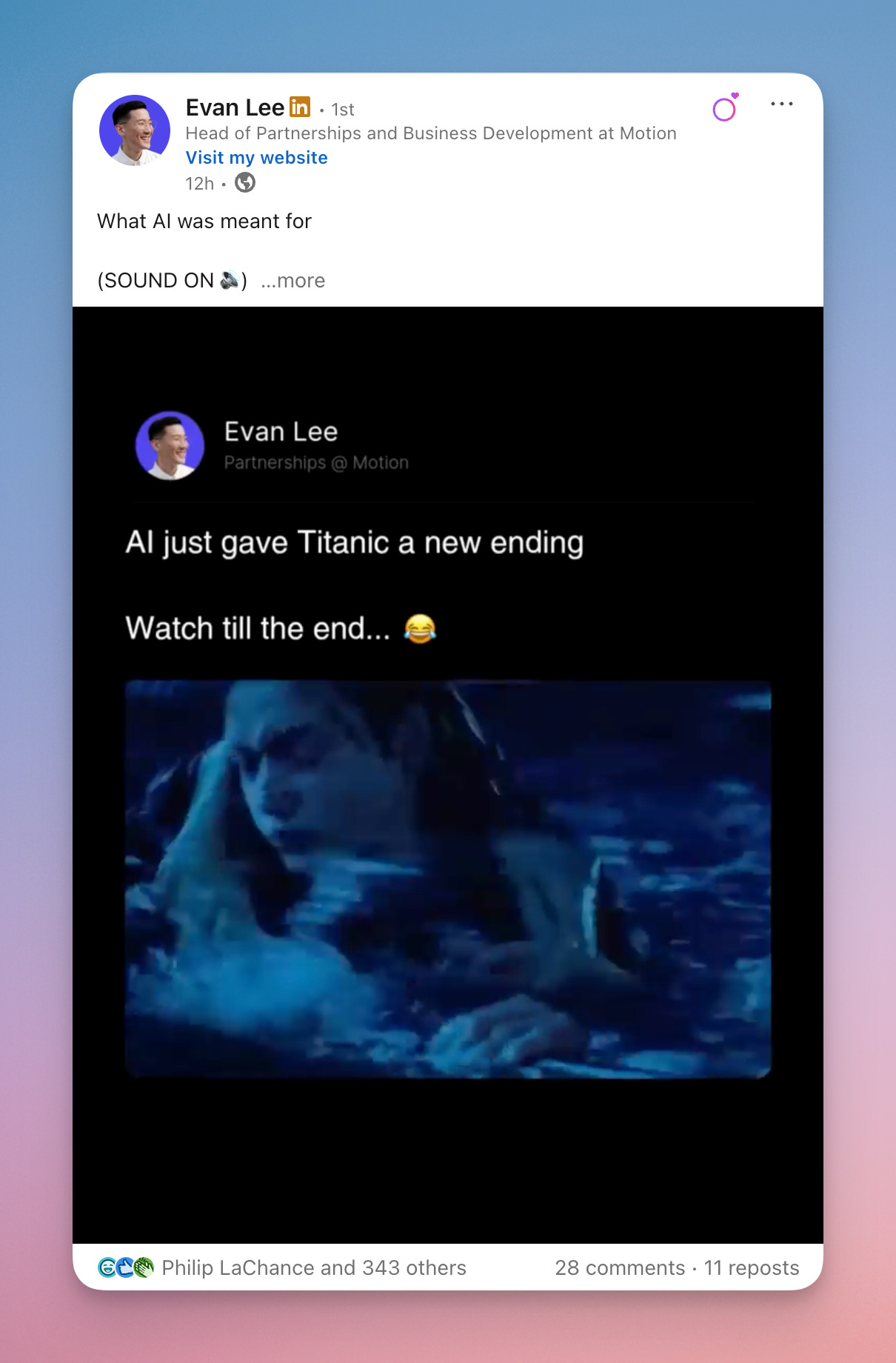LS #65: The LinkedIn Post That Books Demos Without Asking for Them
I used to end every LinkedIn post with “DM me if you want to learn more.” Got 0 demo requests. Then I wrote one post without any CTA. Booked 9 demos in 48 hour
Hi there,
I study LinkedIn’s best posts to show you what works, so your content connects.
In this issue, you’ll find:
The 3 high-performing LinkedIn posts this week
The LinkedIn post that books demos without asking for them
The 3 high-performing posts this week
1. I just joined Lovable! 🥰
Why this post?
This post went viral, receiving 1k likes in a week. It received 50-76 times more engagement and views than Lazar’s posts this month.
BREAKDOWN
Emotional hook: “I just joined Lovable! 🥰“ - pure excitement.
Origin story opening: “When I was six, I got my first computer” - childhood dream setup
Lost dreams acknowledged: “for the last 20 years, most of those dreams started to fade away...” - relatable midlife reality
Age milestone mention: “I turned 36 last month” - specific vulnerability about age and renewed dreams
Single-sentence paragraphs: Creates dramatic emphasis and emotional beats
Permission and encouragement: “if you have a dream, don’t wait. Build it. Share it. Live it.”
POST IDEAS YOU COULD TRY:
“At 40, I finally built the thing I sketched in my notebook at 12”
“I left [Big Tech Company] to join [Startup] - here’s why I’m crying happy tears”
“Joined [Company] today - this isn’t just a job, it’s the mission I’ve been searching for”
“I’m 35 and just started my first dev job - proof it’s never too late”
“Left corporate America for [Startup] - and I remember why I got into tech”
TOGETHER WITH POSTHERO
Grow your audience faster on LinkedIn. With an AI-powered tool that helps you create content and grow on LinkedIn.
Create high-converting content that helps you grow on LinkedIn
Create a weekly content in 76 seconds
AI Voice assistant for creating content in seconds
2. Huge news: We’re changing our company name from Grammarly to Superhuman and launching a new product!
Why this post?
Another post that went viral this week—it got 4.1k likes in a week and performed 30 times better than Shishir’s other posts in October.
This post announced a major rebrand of a well-known company (Grammarly) while simultaneously introducing a new AI assistant product.
BREAKDOWN:
Major news announcement: “Huge news: We’re changing our company name from Grammarly to Superhuman” - immediate attention grab
Product expansion signal: “and launching a new product!” - doubles the newsworthy elements
Multi-product strategy: Lists Grammarly, Coda, Superhuman Mail as portfolio - shows expansion not pivot
New product introduction: “Superhuman Go” as AI assistant - reveals the innovation.
Visual product demo: Video shows AI understanding context and suggesting actions.
3. What AI was meant for
Why this post?
This post got 2-23 times more engagement than Evan’s other posts this week.
WHY THIS POST WENT VIRAL
The post combined entertainment (AI giving Titanic a happy ending) with practical business education (5 AI strategy learnings).
BREAKDOWN:
Philosophical opening: “What AI was meant for“ - sets up big reveal
Humor hook: “AI just gave Titanic a new ending” - unexpected and amusing premise
Watch instruction: “Watch till the end... 😂” - creates anticipation and commitment
Personal learning frame: “5 things I wish I knew before building our AI Creative Strategists” - vulnerability and value
Myth-busting format: Challenges common assumptions (“AI = cheaper/faster. That ain’t it”)
HOW TO CREATE YOUR OWN POST:
“What [Technology] was actually meant for (not what everyone thinks)”
“AI just [did unexpected thing] - but here’s what it should really do”
“5 things I wish I knew before building [product category]”
“Watch this AI fail... then learn what actually works”
“The [funny/viral video] - now here’s the serious business lesson”
LinkedIn Guide
The LinkedIn post that books demos without asking for them.
I used to end every LinkedIn post with “DM me if you want to learn more.”
Posted 5 times a week for 2 months. Got 0 demo requests.
Then I wrote one post without any CTA. Booked 9 demos in 48 hours.
Here’s what I learned: The harder you ask, the less they respond. The more value you give, the more they reach out.
The Demo Request Problem
What most founders do:
End posts with “Book a call with me”
Add calendar links in comments
Ask “Who wants to know more?”
Direct people to their website
Why this fails:
Feels pushy and salesy
Breaks the value-first trust
Makes people defensive
Triggers sales resistance
The reality: Decision-makers don’t book demos because you asked. They book demos because they see themselves in your solution.
The Psychology of Inbound Demo Requests
What triggers prospects to reach out:
They recognize their exact problem in your post
They see results they want to achieve
They realize their current approach isn’t working
They feel you understand their situation deeply
What doesn’t trigger outreach:
Generic offers to help
Calendar links in bio
“Let’s chat” CTAs
Talking about your product features
The shift: From “Here’s my solution, book a call” to “Here’s how I solved this exact problem, here’s what worked.”
The 3 Demo-Generating Post Formulas
Formula #1: The Detailed Problem Breakdown
Structure: Specific problem + Hidden causes + Unexpected insight + Results from fixing it
Example post that generated 7 demos:
Hook: “Our customer onboarding completion rate was 23%. Industry average is 60%. We assumed our onboarding was too complicated. Wrong.”
Key insight in the post: [Explained the real problem was asking for too much information upfront - 47 fields across 8 steps scared users away. Progressive disclosure fixed it.]
Ending: “Result: Completion rate 23% → 71% in 60 days. The lesson: People commit to what they can see, not what they imagine.”
Why this generated demos:
Founders with low completion rates saw themselves
Specific numbers made it credible
The lesson was counterintuitive
No CTA, just valuable insight
What happened: 7 founders DMed my client asking “How did you implement progressive disclosure?”
Natural conversation → demo discussion.
Formula #2: The Failed Attempt Story
Structure: What we tried + Why it failed + What actually worked + Surprising insight
Example post that generated 11 demos:
Hook: “We spent $15K on landing page optimization to improve our conversion rate. Hired a designer. Ran A/B tests. Changed copy 12 times. Conversion rate improved from 2.1% to 2.3%. Barely moved.”
Key insight: [Added a 2-minute product demo video to cold outreach emails instead - showed the product solving a specific problem, didn’t sell.]
Ending: “Conversion rate jumped to 8.1% in 30 days. Best $300 we ever spent (Loom subscription + 2 hours of recording time).”
Why this generated demos:
Relatable failure (most have tried landing page optimization)
Unexpected solution (video in email, not on landing page)
Specific ROI ($300 investment, massive return)
Counterintuitive insight
What happened: 11 founders DMed asking “What did you show in the video?” Led to demos to see the client’s approach.
Formula #3: The Metric Transformation Deep-Dive
Structure: Metric before/after + What everyone tries + What we did differently + The non-obvious insight
Example post that generated 9 demos:
Hook: “Our sales cycle: 4.5 months. After one change: 2.1 months.”
Key insight: [Changed from broad ICP (50-500 employees) to super specific ICP with behavioral signals like “posted about retention challenges in the last 90 days”.]
Ending: “Sales cycle: 4.5 → 2.1 months. Demo-to-close: 18% → 41%. The surprising part: Fewer leads, more revenue. We went from 120 demos/month to 40, but closed deals went from 8 to 16.”
Why this generated demos:
Founders with long sales cycles related immediately
Counterintuitive approach (narrow ICP, not widen it)
Multiple metrics showing impact
Specific ICP criteria they could apply
What happened: 9 founders DMed variations of “How did you identify the buying signals?” Natural transition to demo conversation.
The 5 Elements of Demo-Generating Posts
Element #1: Extreme Specificity
Not: “We improved our metrics”
But: “Churn dropped from 18% to 6% in Q3 for annual contract customers”
Why it works: Only people with that exact problem pay attention
Element #2: Counterintuitive Insight
Not: “We followed best practices and it worked”
But: “We ignored best practices and got better results”
Why it works: Creates curiosity about your unique approach
Element #3: Failed Attempts Before Success
Not: “Here’s what worked for us”
But: “We tried A, B, and C. They all failed. Then we tried D...”
Why it works: Builds credibility, shows you understand the struggle
Element #4: The Non-Obvious Learning
Not: “Hard work pays off”
But: “We discovered that our best customers ignored our main feature”
Why it works: Provides insight they haven’t considered
Element #5: No CTA Required
Not: “DM me if you want to learn how”
But: [End with the insight, let them reach out naturally]
Why it works: Removes sales pressure, creates pull instead of push
What NOT to Include
❌ Calendar Links
“Book a call: [link]”
Why it fails: Too direct, triggers sales resistance
❌ Generic CTAs
“DM me to learn more”
“Interested? Let’s chat”
“Want help with this?”
Why it fails: Feels like every other sales pitch
❌ “I can help you” Statements
“If you’re struggling with this, I can help”
Why it fails: Sounds self-serving, not value-giving
The Comment Strategy That Amplifies Demo Requests
What to do after posting:
Hour 1: Reply to every comment with additional insights
Don’t just say “Thanks!”
Add more value
Answer with specifics
Example: Comment: “This is interesting, how long did it take to see results?”
Bad response: “Thanks! About 60 days.”
Good response: “About 60 days, but we saw leading indicators within 2 weeks. The key was tracking daily active usage instead of waiting for renewal rates. Happy to share the specific metrics we monitored if useful.”
Hour 2-24: Engage with commenters’ profiles
Check if they’re in your ICP
Like/comment on their recent posts
Build relationship before they reach out
Result: When they DM, it’s a warm conversation, not a cold outreach response.
Example Demo-Generating Posts Analysis
Post A: Generic advice “5 ways to improve customer retention:
Better onboarding
Proactive support
Regular check-ins
Feature education
Renewal campaigns”
Results: more likes, 0 demo requests
Post B: Specific problem-solving “Why our customer retention was stuck at 78% despite doing everything ‘right’:
We had great onboarding, proactive support, and regular QBRs.
The problem wasn’t what we were doing. It was when.
We were checking in on monthly schedules. But our data showed customers made renewal decisions in week 6-8, not month 11-12.
Changed our cadence to align with their decision timeline.
Retention jumped from 78% to 91% in one quarter.”
Results: less likes, more demo requests
The difference: Specific problem, counterintuitive insight, actual results.
The Demo Request Pattern
What qualified prospects say when reaching out:
Pattern #1: The Identification “This is exactly what we’re dealing with...”
Pattern #2: The Question “How did you implement [specific thing you mentioned]?”
Pattern #3: The Validation “We tried something similar but different outcomes. What did we miss?”
Pattern #4: The Direct Ask “Would love to learn more about your approach. Open to a call?”
Your response framework:
Acknowledge their situation
Share one more insight
Suggest a conversation to go deeper
No pressure, make it natural
The Demo-Generating Post Formula
Specific Problem with Numbers (only ICP relates) + Failed Attempts (builds credibility) + Unexpected Solution (creates curiosity) + Counterintuitive Insight (shows unique thinking) + No CTA (removes sales pressure) = Inbound demo requests
Stop asking for demos. Start earning them.
That’s a wrap for today.
See you next week! If you want more LinkedIn tips, be sure to follow me on LinkedIn (link).
If you love this episode and want to support us, spread the word about us by sharing The LinkedIn Secrets with colleagues. I really appreciate it!
Thank you for reading!
What’d you think of today’s edition?
Help me to understand what you think about this episode. Just reply with a number (1, 2, or 3) to this email.
1 - Damn good
2 - Meh, do better
3 - You didn’t cook it
Your compadre,
Anton “LinkedIn growth strategies” Cherkasov





